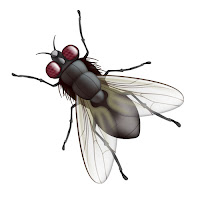Image adapted from one used as part of the Wake Up Punk project
conceived by Joe Corré and Nigel Askew
I.
When I was a young child at school, one of the songs that we were encouraged to sing - despite nobody in the classroom knowing any Spanish - was the popular Mexican folk song La Cucaracha.
Whilst entirely ignorant of the song's lyrics, origins, and significance, it did inspire in me a love of songs about insects and pieces of music which either imitate or incorporate the sounds made by our six-legged friends.
This ranges from Rimsky-Korsakov's Flight of the Bumblebee (1900), a classical composition intended to musically evoke the seemingly chaotic and rapidly changing flight pattern of a bumblebee, to big-hearted Arthur Askey's silly (and somewhat irritating) Bee Song (1938), written by Kenneth Blain.
II.
Of course, not all insect songs are about bees and don't merely possess novelty value. Thus it is, for example, that some of the finest examples of punk rock - in its broadest and best sense - are about insects.
These include:
(i) Wire: 'I Am The Fly', written by Colin Newman and Graham Lewis, released as a single in February 1978 and also found on their second studio album Chairs Missing (Harvest, September 1978): click here.
Sample lyric:
I am the fly in the ointment
I can spread more disease than the fleas
Which nibble away at your window display
(ii) The Cramps: 'Human Fly', written by Poison Ivy Rorschach and Lux Interior, originally released in November 1978 on Vengeance Records, it can also be found on the 12" EP Gravest Hits (Illegal Records / I.R.S. Records, July 1979): click here.
Sample lyric:
Well I'm a human fly
I, I said F-L-Y
I say buzz buzz buzz
And it's just becuz
I'm a human fly
And I don't know why
I got 96 tears and 96 eyes
(iii) Blondie: 'The Attack of the Giant Ants', written by Chris Stein, final track on side two of the eponymous debut album Blondie, (Private Stock Records, December 1976). Click here to play the remastered version from 2001.
Sample lyric:
Giant ants from space
Snuff the human race
Then they eat your face
Never leave a trace
(iv) Adam and the Ants: 'Antmusic', written by Adam Ant and Marco Pirroni, the third single from the second studio album Kings of the Wild Frontier (CBS / Epic, November 1980). Click here to watch the official video, dir. Steve Barron, on YouTube.
Note: the single got to number two in the UK charts in January 1981 and would've been a number one were it not for the fact that John Lennon's 'Imagine' was re-released following his murder in December 1980. As I remarked at the time, it's a sad day for pop music when a dead Beatle can crush a live Ant.
Sample lyric:
Don't tread on an ant, he's done nothing to you
There might come a day when he's treading on you
Don't tread on an ant, you'll end up black and blue
You cut off his head, legs come looking for you
(v) And finally, let's not forget the track 'Insects', by Altered Images, which can be found on their debut studio album Happy Birthday (Epic Records, September 1981), vocals by the punk generation's very own version of Lulu, Clare Grogan. Click here to watch a live performance of the song on The Old Grey Whistle Test (24 November 1981).
Sample lyric:
Insects
Insects
See them crawling
Insects
In their thousands
Finally, let me note in closing that there are, of course, other punk and post-punk songs that could be added to this list. We might include, for example, 'Insects' by Osaka Popstar (2006), or Danny Elfman's 2021 reworking of the Oingo Boingo track of the same title from 1982: click here.
The five songs selected above, however, remain my personal favourites; although they are not listed in any preferential order.
Note: for an academic take on this question of insects in relation to popular music, see Joseph Coelho, 'Insects in Rock & Roll Music', American Entomologist, Volume 46, Issue 3, (Fall 2000), pp. 186–200. Click here to access this work online as a pdf. Thanks to Thom Bonneville for this reference.
For a related post to this one, entitled 'Punk Moth', click here.
And click here for a follow up post, in which I reply to a critic and discuss a little known song by the Clash, 'How Do I Understand the Flies?'





